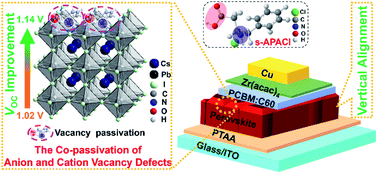Molecular interactions and functionalities of an organic additive in a perovskite semiconducting device: a case study towards high performance solar cells†
Abstract
A chiral aromatic amino acid, (S)-3-amino-4-phenylbutyric acid hydrochloride (s-APACl), was employed as an additive to the active layer in a p-i-n organic–inorganic halide perovskite solar cell. This additive led to a better ordered crystal grain with vertical alignment and strongly n-dominated semiconducting properties of the perovskite layer. The s-APACl additive passivated the perovskite predominantly at grain boundaries rather than in the bulk. Both –C![[double bond, length as m-dash]](https://www.rsc.org/images/entities/char_e001.gif) O and –NH3+ functional groups interacted strongly with the perovskite, forming coordination with the PbI2 cage, and passivated the defects at grain boundaries; they also reduced the trap or defect densities to suppress non-radiative recombination and to give enhanced photoluminescence with longer lifetimes, suppressed decomposition in the perovskite layer, stabilized the interface structure and reduced ion migration, which enhanced the stability of the device. A device with 1 mole% s-APACl showed an increase in power conversion efficiency to 21.02% (from 18.90% for the control device) with substantially enhanced operational stability. This work offers a comprehensive understanding of a multi-functional additive in a perovskite device.
O and –NH3+ functional groups interacted strongly with the perovskite, forming coordination with the PbI2 cage, and passivated the defects at grain boundaries; they also reduced the trap or defect densities to suppress non-radiative recombination and to give enhanced photoluminescence with longer lifetimes, suppressed decomposition in the perovskite layer, stabilized the interface structure and reduced ion migration, which enhanced the stability of the device. A device with 1 mole% s-APACl showed an increase in power conversion efficiency to 21.02% (from 18.90% for the control device) with substantially enhanced operational stability. This work offers a comprehensive understanding of a multi-functional additive in a perovskite device.



 Please wait while we load your content...
Please wait while we load your content...